Text


The Goddess Adored - devotees praying to and praising Devi
Folio possibly from a Saundaryalahari or Dashamahavidya series From the family workshop of Nainsukh of Guler
Pahari region, c. 1815
Horst Metzger Collection
139 notes
·
View notes
Text
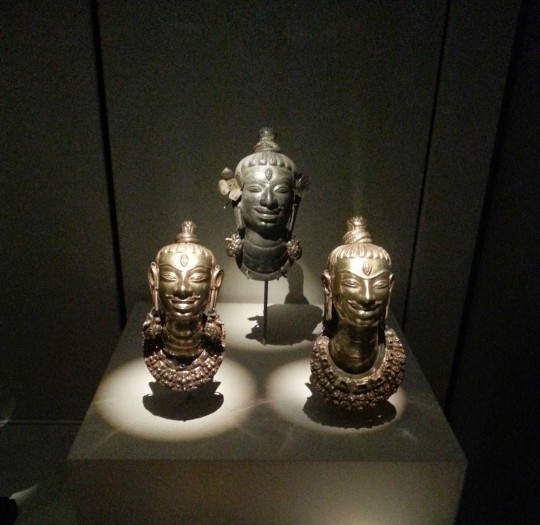
Mukhalingas - Shiva is most commonly worshiped in the aniconic Linga form; however Lingas with a face can be found throughout South East Asia where Shaivism was widespread from the 6th to the 14th Centuries. These silver and gold Mukhalingas are from Champa - what is today Central Vietnam. Displayed at Asian Civilizations Museum, Singapore
23 notes
·
View notes
Text

Sri Vishnu in Kurma Avatar - the turtle form, supporting Mt Mandara that was being used to churn the oceans. This is the central portion in the massive bas relief of Samudra Manthan adorning the southern portion of the east gallery at Angkor Wat.
34 notes
·
View notes
Photo


The Highest Blessing
52 notes
·
View notes
Text

Buddha Purnima - the sacred full-moon day commemorated as the day of Buddha Jayanti, when the Enlightened One was born in the grove at Lumbini. Legend has it that Queen Mayadevi gave birth standing up and the infant Prince Siddhartha walked seven steps at that instant of birth.


According to Theravada tradition, this also marks the day the Blessed Lord attained Enlightenment (Nirvana) and the day of the great passing (Maha Parinirvana). Sharing these exquisite images representing these three momentous events in the life of Sakyamuni from various parts of the Indian subcontinent.
59 notes
·
View notes
Photo


Shiva Parivar
Tanjore painting panel depicting Uma Maheshwara astride Nandi, flanked by Ganesha and Skanda. Circa 18th Century
Government Museum, Bangalore
55 notes
·
View notes
Photo



Indra and Sachi
Indra deva, the lord of paradise and his consort Devi Sachi astride their vahana the elephant Airavata. Indra is depicted wielding the vajra thunderbolt.
Hoysala style, circa 12th Century CE
Government Museum, Bangalore
43 notes
·
View notes
Photo

How many NRIs / PIOs - both first and second generation, feel this in their bones?
18 notes
·
View notes
Photo










Talāī Bhadrakālī Mañdir
In the town of Talāī, Māśobrā near Śimlā amidst the pine and deodar trees is this shrine to Devī Bhadrakālī, the benevolent protective form of Devī Mahākālī.
The present temple is of somewhat recent provenance but the pahāḍī architecture and styling made of ornately carved wood is of highly traditional design. The sloping roof is designed for snow to slide off; the ornate carvings depict geometrical patterns as well as images of Hindu deities.
#Devī Bhadrakālī#Talāī Bhadrakālī Mañdir#Hinduism#Hindu Art#hindu architecture#Hindu Temple#Bhadrakali#Mahakali#Mother Goddess
65 notes
·
View notes
Text



The daliances of Radha and Shri Krishna
Radha playfully mock whips Shri Krishna with her dupatta. Folio from Geeta Govinda manuscript - the second work on this theme - from Guler.
The second generation of masters after Manaku and Nainsukh, circa 1775 - 1780 CE
Pahari style, Guler
Collection of Horst Metzger
#hinduism#indic art#hindu art#Indian Miniature Painting#Pahari Style#Guler#Shri Krishna#Geeta Govinda#Radha Krishna
117 notes
·
View notes
Photo
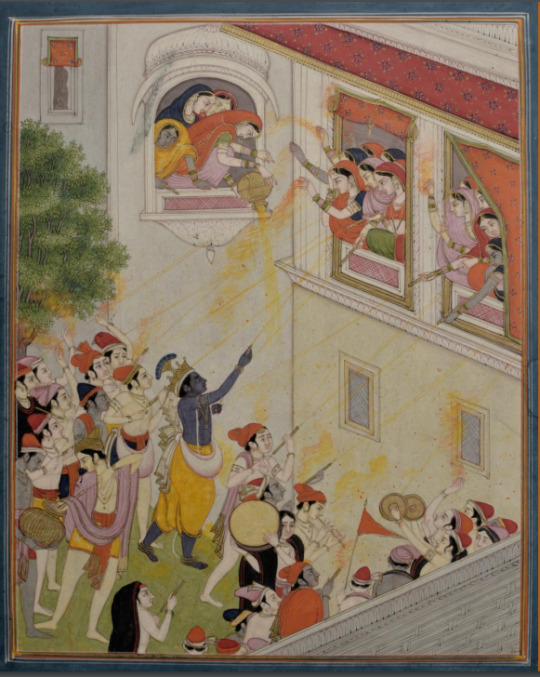
Krishna playing colour with the Gopikas
On occasion of Dhulwad - Dhuleti (धूळवड - धुलेटी), may the festival of colours bring joy and togetherness
Pahari Miniature, Kangra Style, circa 1800 CE
National Museum, New Delhi
#Holi#Dhuleti#Krishna#Shri Krishna#Krishna playing Holi#Hindu Art#Hindu Miniature#Kangra Style#Indic Art
285 notes
·
View notes
Text
Śṛī Deva Rāmeśwara Maṅdira – श्री देव रामेश्वर मंदिर
Following up on my earlier post on the cluster of five temples that constitute the Mālvaṇ Deuḷwāḍā, the first i.e., oldest, and foremost temple is that of Śṛī Deva Rāmeśwara, dedicated to Lord Śiva Mahādeva as the patron deity or Iṣṭadeva of Lord Śṛī Rāma – Īśwara of Rāma whence Rāmeśwara. The first recorded large temple in the spot was built circa 1920.

The temple is described as jāgṛt – literally meaning ‘awakened’, conveys that devotees report feeling the presence of the deity in this shrine.
The Gāvkar clan has the honour and responsibility of keeping the temple functioning and well maintained (मानकरी). The shrine also has designated person for worship ritual (पुजारी), recitation of holy texts (पुराणिक) and performance of sacred songs (कीर्तनकार) – all these roles are fulfilled by families residing in Deuḷwāḍā.The present temple was renovated around 10 years ago and has two spacious halls leading up to the sanctum sanctorum (गर्भगृह) which are used for congregations and worship rituals.
The tiled floor and concrete pillars replace the older stone flooring and wooden pillars.

Back in the day menfolk in the neighbourhood often took some light bedding to sleep in the out hall of the temple on hot summer nights - when the stone and wooden temple with high ceiling would often be cooler than their homes. No one was supposed to sleep in the centre of the hall though. According to legend, that was the path the the devchār - the king of ghosts - tread at the stroke of midnight as he walked in to prostrate himself before Lord Śiva. Any impudent human sleeping in the path would be kicked out of the way!
The ornate tiling in the inner hall is where the purāṇik - the reader of sacred texts purāṇik - sits facing the deity.

The sanctum sanctorum where is installed the sacred deity.

In front of the temple stand the tipor – pillars of light which are lit up with oil lamps Mahā Śivarātrī; behind the tipor is the nagārkhānā formerly used to house the musical instruments for the temple (drums and trumpets), this now has a loudspeaker.

The outer entrance is decorated with stucco images framed in a kīrtimukha, a clear influence of southern temple architecture.

On special occasions and festival celebrations, the presiding deities of the two main shrines of Deuḷwāḍā – Śṛī Deva Rāmeśwara and Śṛī Deva Nārāyaṇa – are taken out in a procession circumambulating the two temples accompanied by percussions and religious songs. Specially made silver icons of the deities are used for this.

In all the change that modernity brings in, some corners remain where tradition holds fast.
65 notes
·
View notes
Photo



Caṇḍeśānugrahamūrti (चण्डेशानुगृहमूर्ति) – Lord Śiva blessing Caṇḍeśa
One of the most striking sculptures found in the Bṛhadīśwara Temple at Gañgāikoṇḍa Coḷapuram is a classical murti or form of Lord Śiva, that of Caṇḍeśānugrahamūrti – thus form is based on the legend of the Śaiva devotee Caṇḍeśa who was blessed by Lord Śiva – the Caṇḍeśa in this sculpture in this temple represents the king Rājendra Coḷan himself. Depicted here in life size high bas relief, kneeling at the feet of the Lord who bestows his blessings by winding a garland of flowers around the king’s crown while Devī Umā Parameśwarī looks on benignly.
The temple is believed to have been completed in 1035 CE in the 9th regnal year of King Rājendra I
Bṛhadīśwara Temple, Gañgāikoṇḍa Coḷapuram
#Caṇḍeśānugrahamūrti#Chandeshanugrahamurti#Lord Śiva blessing Caṇḍeśa#Bṛhadīśwara Temple#Gañgāikoṇḍa Coḷapuram#gangaikondacholapuram#Hindu Art#Hinduism#Hindu Sculpture#Chola Art
41 notes
·
View notes
Text
Malvan Deulwada - मालवण देऊळवाडा
Most towns in the south Konkan have a cluster of shrines and temples dedicated to the deities of the village (ग्रामदेवता). These form the focal point of religious celebrations for the town.
Such a cluster of temples and houses, houses of clans responsible for temple ceremonies and upkeep (मानकरी) and officiating Brahmins responsible for Nitya Puja and other rituals, is called a Deulwada.
The Deulwada of Malvan (coastal town in the Sindhudurg district of Maharashtra, just north of Goa), is centered around five temples, each dedicated to a local deity which is also a form of one of the principal Gods of Hinduism. These are: 1. श्री देव रामेश्वर - Lord Shiva

2. श्री देव नारायण - Lord Vishnu

3. श्री देवी सातेरी - Goddess Durga

4. श्री देवी भावई - Goddess Maha Lakshmi

5. श्री देवी पावणाई - Goddess Maha Saraswati

Over the next few days, I will follow up with more detailed posts on each temple.
59 notes
·
View notes
Photo



Phật – the Buddha
Gilt wood, 17th Century CE
Japan
Museum of Vietnamese History, Saigon
142 notes
·
View notes
Text
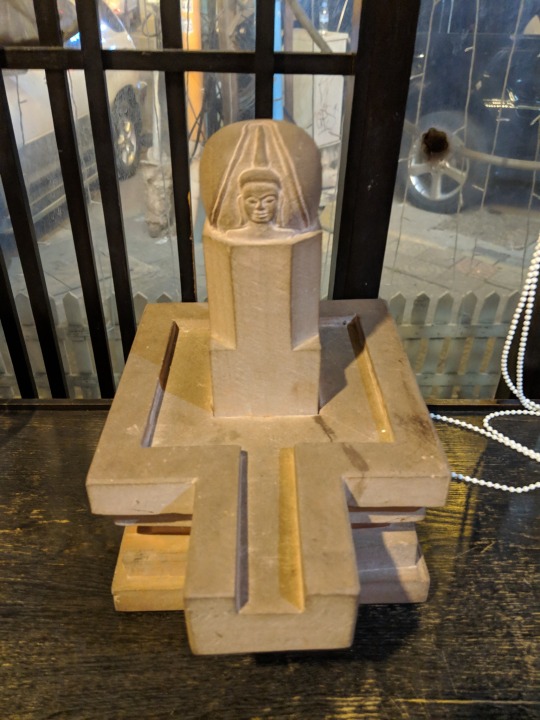
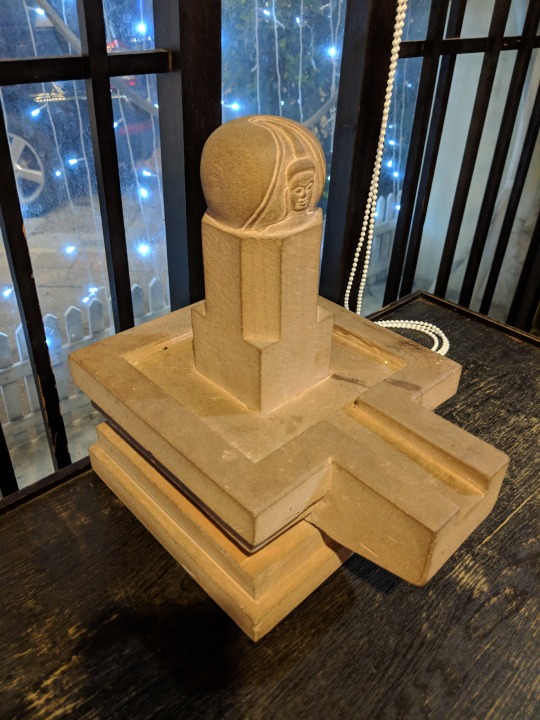
Mukhaliñga
The traditional aniconic representation of Lord Śiva in form of the Liñga – this representation is unusual in that the octagonal and cuboid bases of the Liñga are depicted over the Yoni patala or base.
Contemporary stonework, Thailand
43 notes
·
View notes
Text
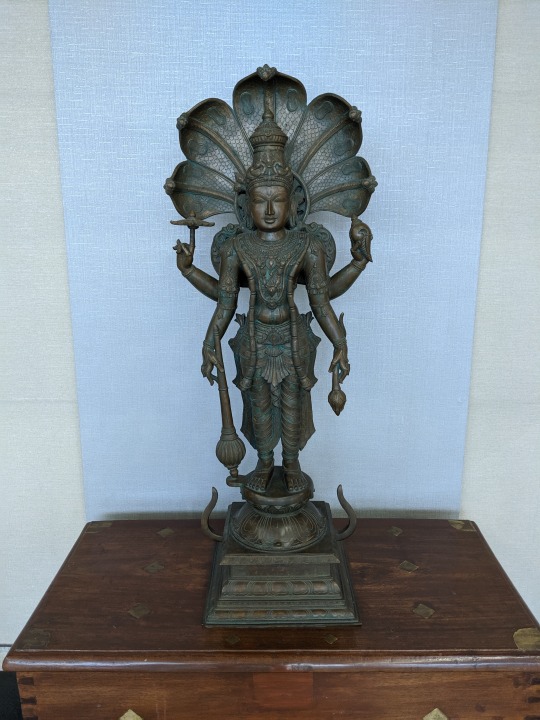
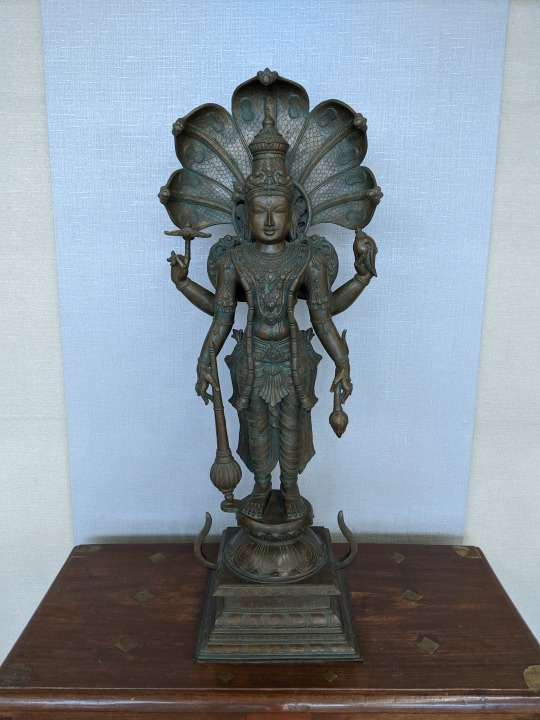
Caturbhuja Śṛī Mahā Viṣṇu
Contemporary Bronzework in the Chola Tradition
Chennai
33 notes
·
View notes